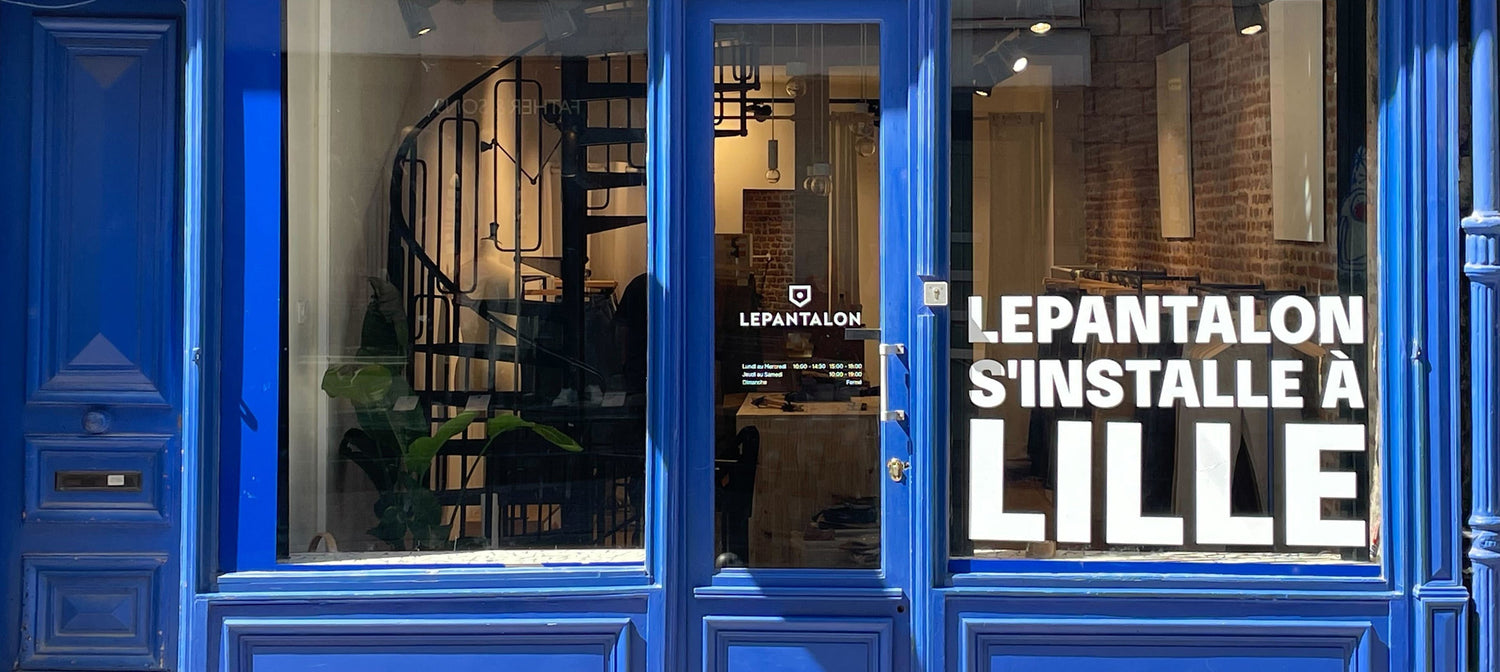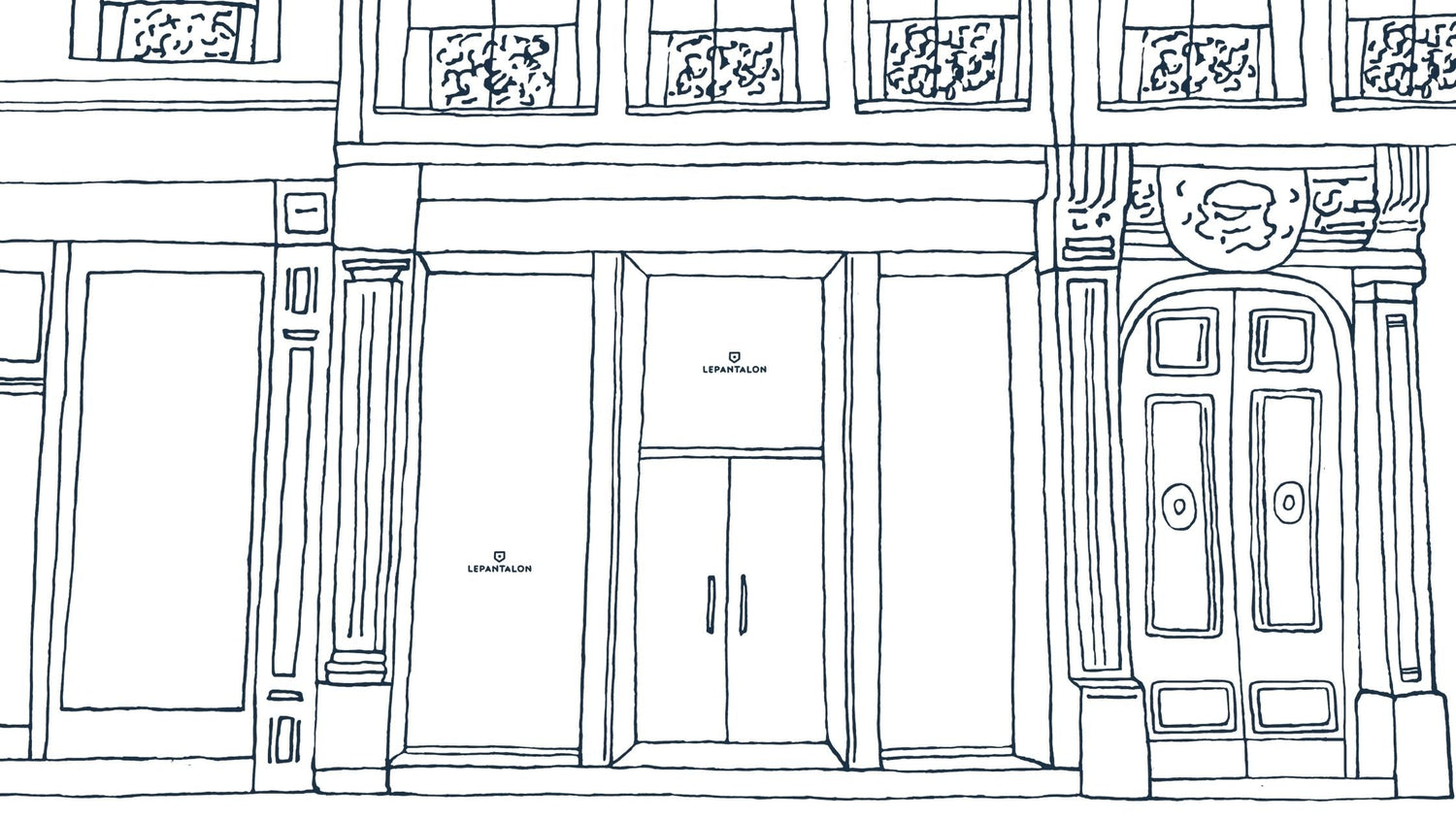Selvedge, barb, sartorial finishes, braid... What are the specificities of trousers and you? We grant you, it's a bit complex.
But as specialists, it's our duty to guide you through these somewhat barbaric terms! Here, we explain everything so that pants no longer hold any secrets for you!
And for even more information, click on the names of the definitions: you will be redirected to a fully dedicated article, for a complete and ever more detailed explanation! 😉
The finishing touches of the trousers
Sartorial Finishes : (adj.) Derived from the Latin word "sartor", the word is also widely used in Italy since Sarto means "tailor". These finishes are the set of operations intended to perfect a finished product by the installation of various accessories. For example, the barb, the braids and the V of ease are sartorial finishes.

Our sartorial finishes:
The pin buckle : (nm) It's a small loop of fabric at the closure of the pants, into which you simply slide the metal tip of the belt to keep it securely in place. You must surely know that feeling of a belt turning, that you constantly have to put back in place! Well, with the pin buckle that's over, your belt will stay in its original place.

Braid : (nf) This is a strip of fabric that covers the inside seams of trousers to make them stronger and more attractive. For example, on our Raw Jeans and Bermuda shorts, they are made with the iconic LePantalon floral pattern.

V of ease : (nm) It's this small slit at the back of the waistband. It is found on tailor-made or tailored trousers. This gives the waistband a certain flexibility when you sit down or when you are between two sizes: essential for comfortable trousers! Sometimes with certain trousers you feel tight, especially after lunch, this is where the V of ease comes in. This allows you to feel more comfortable at the waistband and allows for a certain margin which is not to be refused after a meal.

Rivet : (nm) These are the metal studs located in the corner of jeans pockets, invented by Levi Strauss in 1873 to reinforce pockets. At the time, their primary function was to reinforce the clothing of workers and cowboys. Today, it prevents your pockets from wearing out over time, and adds a real aesthetic to a pair of raw jeans.

For our pockets:
Backstitch : (nm) To finish sewing the trouser pockets, we use a backstitch. It is an additional seam that reinforces the main seam (it looks like a small sausage). This way, your pockets are not likely to loosen over time.

Piped Pockets : ( pockets , adj.) This is a cut pocket, the opening of which is a slit bordered by one or two braids 1 to 2.5 cm wide. Discreet and elegant, these are the back pockets of our Chinos, Bermuda shorts and Flannels.

To roll up your pants:
Hem : (nm) This refers to the seam at the bottom of the trousers. A simple hem can be made by folding the lower part of the trousers inwards. The hem is usually sewn with an invisible stitch to create a finish on suit trousers or flannel trousers.

Turn-up : (nm) This also refers to the lower part of your pants, but it is made by folding the fabric outwards, unlike the hem. There are two types of turn-up: the machine turn-up, as its name suggests, is made with a sewing machine. Its size can vary between 2.5 cm and 5 cm, although some people have fun making it go up to 6 or even 10 cm (on selvedge jeans). Where the hand turn-up, this one is much more random in terms of size since it is done by hand, so by yourself.

Pinroll : (nm) Refers to a technique of tightening the ankle. Highly prized by sneakerheads, the Pinroll is very popular on social media as well as internationally. Designed to show off your shoes, this technique allows you to raise and tighten your pants, thus revealing your ankles. This technique is generally used on jeans; it is a kind of tighter cuff at the ankle.

The fabric of the pants
Flannel : (nf) This means that the fabric has been rubbed and pressed to achieve that felted appearance and a softer feel. The added bonus is that this technique traps air in the fabric, which helps protect us from the cold. Flannel is often made of wool, but you can find some made of cotton. In fact, our Flannel is, as the name suggests, made of wool flannel, which is why they are so warm in winter!

Selvedge : (nm) Selvedge refers to the twill finish of a pair of jeans. It is a uniform finish of a fabric at its end that forms a border and helps to reinforce the jeans by providing strength. The edges of non-selvedge denim are not finished cleanly, they are topstitched, and can therefore easily fray.

Oz : (nm) Abbreviation for “Ounce”, in English. This measurement is used to indicate the weight of the denim (13 oz, 11 oz, etc.). So the higher the weight, the thicker and heavier the denim.

Raw : (nf) This means that the denim fabric of the jeans has not been treated after manufacture. It is therefore in its natural, raw state. That is to say, its color or appearance has not been modified. Thus, raw fabric will fade over time depending on how it is worn, to create a unique pair of jeans.

Chiné : This is a fabric whose threads have been dyed in different colors to form a pattern on the fabric once the threads are woven. This is a very old technique, but has only been popular since the 1930s. It was formerly used on silk, but nowadays it is used on all types of fabrics.

The cut of the pants
The four most common cuts:
Slim fit: (adj.) its waist is straight at the hips, with a tight, close line all along the leg as well as a small leg opening. Be careful, the fabric should not mold to the leg (in this case we are more on a cut that is called Skinny, mainly found on women).

Straight cut: (adj.) characterized by a straight leg line from the waist to the ankles, it is particularly suitable for men with wide thighs. However, be careful not to choose it too big or too long so as not to flatten the silhouette! This cut adapts to all body types, small or large. It is also the shape to choose if you are a little heavy.

Carrot cut: (adj.) loose at the thighs, to slim down from the knee. As its name suggests, this cut has the particularity of having a shape close to that of the carrot. It is a particularly comfortable cut that adapts to several body types: from the thinnest to the thickest thighs.

The semi-slim cut : (adj.) Fitted at the thighs, but straight on the calves, this cut is the cut that flatters most figures. It will highlight the buttocks, lengthen and refine the silhouette. At LePantalon, we only use this one. Yes, our cut is unique!

If you have any questions about the pants, don't hesitate to ask!


